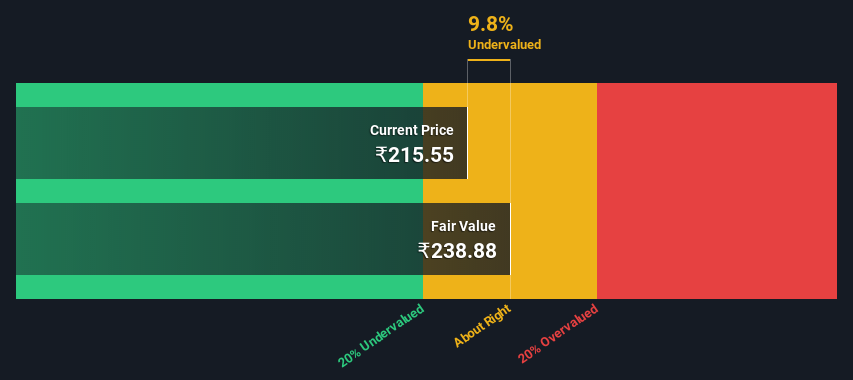- India
- /
- Hospitality
- /
- NSEI:KAMATHOTEL
Calculating The Fair Value Of Kamat Hotels (India) Limited (NSE:KAMATHOTEL)

Key Insights
- Using the 2 Stage Free Cash Flow to Equity, Kamat Hotels (India) fair value estimate is ₹239
- With ₹216 share price, Kamat Hotels (India) appears to be trading close to its estimated fair value
- Kamat Hotels (India)'s peers are currently trading at a premium of 821% on average
How far off is Kamat Hotels (India) Limited (NSE:KAMATHOTEL) from its intrinsic value? Using the most recent financial data, we'll take a look at whether the stock is fairly priced by projecting its future cash flows and then discounting them to today's value. Our analysis will employ the Discounted Cash Flow (DCF) model. Models like these may appear beyond the comprehension of a lay person, but they're fairly easy to follow.
We generally believe that a company's value is the present value of all of the cash it will generate in the future. However, a DCF is just one valuation metric among many, and it is not without flaws. If you still have some burning questions about this type of valuation, take a look at the Simply Wall St analysis model.
Check out our latest analysis for Kamat Hotels (India)
The Method
We use what is known as a 2-stage model, which simply means we have two different periods of growth rates for the company's cash flows. Generally the first stage is higher growth, and the second stage is a lower growth phase. To begin with, we have to get estimates of the next ten years of cash flows. Seeing as no analyst estimates of free cash flow are available to us, we have extrapolate the previous free cash flow (FCF) from the company's last reported value. We assume companies with shrinking free cash flow will slow their rate of shrinkage, and that companies with growing free cash flow will see their growth rate slow, over this period. We do this to reflect that growth tends to slow more in the early years than it does in later years.
Generally we assume that a dollar today is more valuable than a dollar in the future, so we need to discount the sum of these future cash flows to arrive at a present value estimate:
10-year free cash flow (FCF) forecast
| 2023 | 2024 | 2025 | 2026 | 2027 | 2028 | 2029 | 2030 | 2031 | 2032 | |
| Levered FCF (₹, Millions) | ₹711.0m | ₹790.3m | ₹868.2m | ₹945.8m | ₹1.02b | ₹1.10b | ₹1.19b | ₹1.27b | ₹1.37b | ₹1.46b |
| Growth Rate Estimate Source | Est @ 13.03% | Est @ 11.16% | Est @ 9.85% | Est @ 8.94% | Est @ 8.30% | Est @ 7.85% | Est @ 7.53% | Est @ 7.31% | Est @ 7.16% | Est @ 7.05% |
| Present Value (₹, Millions) Discounted @ 20% | ₹592 | ₹548 | ₹502 | ₹455 | ₹410 | ₹369 | ₹330 | ₹295 | ₹263 | ₹235 |
("Est" = FCF growth rate estimated by Simply Wall St)
Present Value of 10-year Cash Flow (PVCF) = ₹4.0b
After calculating the present value of future cash flows in the initial 10-year period, we need to calculate the Terminal Value, which accounts for all future cash flows beyond the first stage. For a number of reasons a very conservative growth rate is used that cannot exceed that of a country's GDP growth. In this case we have used the 5-year average of the 10-year government bond yield (6.8%) to estimate future growth. In the same way as with the 10-year 'growth' period, we discount future cash flows to today's value, using a cost of equity of 20%.
Terminal Value (TV)= FCF2032 × (1 + g) ÷ (r – g) = ₹1.5b× (1 + 6.8%) ÷ (20%– 6.8%) = ₹12b
Present Value of Terminal Value (PVTV)= TV / (1 + r)10= ₹12b÷ ( 1 + 20%)10= ₹1.9b
The total value, or equity value, is then the sum of the present value of the future cash flows, which in this case is ₹5.9b. To get the intrinsic value per share, we divide this by the total number of shares outstanding. Relative to the current share price of ₹216, the company appears about fair value at a 9.8% discount to where the stock price trades currently. Remember though, that this is just an approximate valuation, and like any complex formula - garbage in, garbage out.

Important Assumptions
We would point out that the most important inputs to a discounted cash flow are the discount rate and of course the actual cash flows. You don't have to agree with these inputs, I recommend redoing the calculations yourself and playing with them. The DCF also does not consider the possible cyclicality of an industry, or a company's future capital requirements, so it does not give a full picture of a company's potential performance. Given that we are looking at Kamat Hotels (India) as potential shareholders, the cost of equity is used as the discount rate, rather than the cost of capital (or weighted average cost of capital, WACC) which accounts for debt. In this calculation we've used 20%, which is based on a levered beta of 1.364. Beta is a measure of a stock's volatility, compared to the market as a whole. We get our beta from the industry average beta of globally comparable companies, with an imposed limit between 0.8 and 2.0, which is a reasonable range for a stable business.
SWOT Analysis for Kamat Hotels (India)
- No major strengths identified for KAMATHOTEL.
- Interest payments on debt are not well covered.
- Shareholders have been diluted in the past year.
- Current share price is below our estimate of fair value.
- Lack of analyst coverage makes it difficult to determine KAMATHOTEL's earnings prospects.
- Debt is not well covered by operating cash flow.
- Total liabilities exceed total assets, which raises the risk of financial distress.
Looking Ahead:
Although the valuation of a company is important, it shouldn't be the only metric you look at when researching a company. It's not possible to obtain a foolproof valuation with a DCF model. Preferably you'd apply different cases and assumptions and see how they would impact the company's valuation. For example, changes in the company's cost of equity or the risk free rate can significantly impact the valuation. For Kamat Hotels (India), there are three pertinent elements you should further research:
- Risks: For example, we've discovered 6 warning signs for Kamat Hotels (India) (2 are significant!) that you should be aware of before investing here.
- Other Solid Businesses: Low debt, high returns on equity and good past performance are fundamental to a strong business. Why not explore our interactive list of stocks with solid business fundamentals to see if there are other companies you may not have considered!
- Other Top Analyst Picks: Interested to see what the analysts are thinking? Take a look at our interactive list of analysts' top stock picks to find out what they feel might have an attractive future outlook!
PS. The Simply Wall St app conducts a discounted cash flow valuation for every stock on the NSEI every day. If you want to find the calculation for other stocks just search here.
Valuation is complex, but we're here to simplify it.
Discover if Kamat Hotels (India) might be undervalued or overvalued with our detailed analysis, featuring fair value estimates, potential risks, dividends, insider trades, and its financial condition.
Access Free AnalysisHave feedback on this article? Concerned about the content? Get in touch with us directly. Alternatively, email editorial-team (at) simplywallst.com.
This article by Simply Wall St is general in nature. We provide commentary based on historical data and analyst forecasts only using an unbiased methodology and our articles are not intended to be financial advice. It does not constitute a recommendation to buy or sell any stock, and does not take account of your objectives, or your financial situation. We aim to bring you long-term focused analysis driven by fundamental data. Note that our analysis may not factor in the latest price-sensitive company announcements or qualitative material. Simply Wall St has no position in any stocks mentioned.
About NSEI:KAMATHOTEL
Mediocre balance sheet and slightly overvalued.
Similar Companies
Market Insights
Community Narratives



